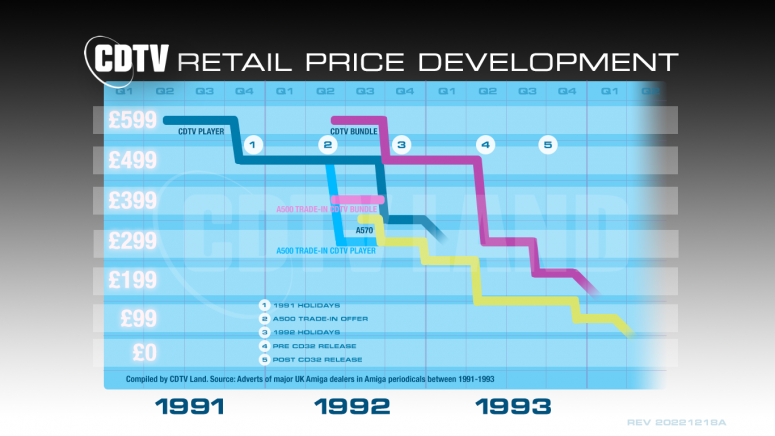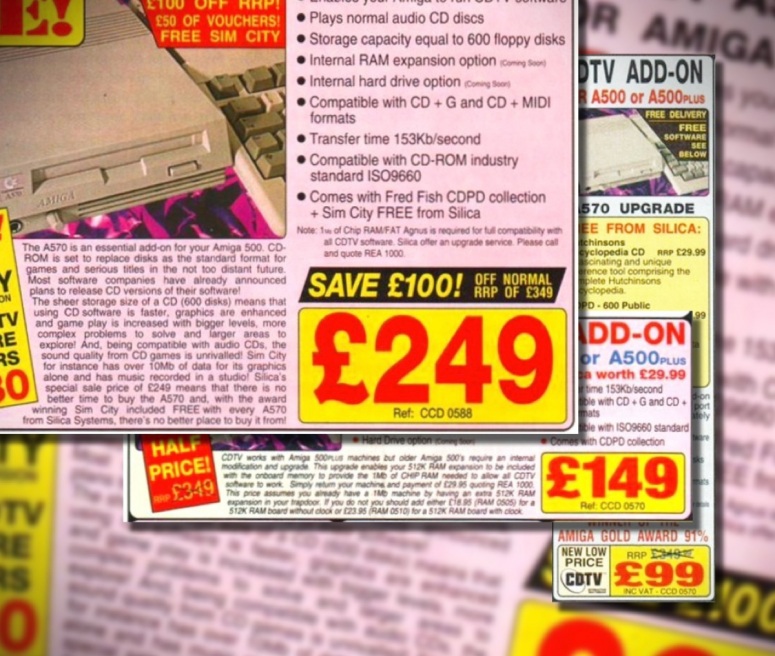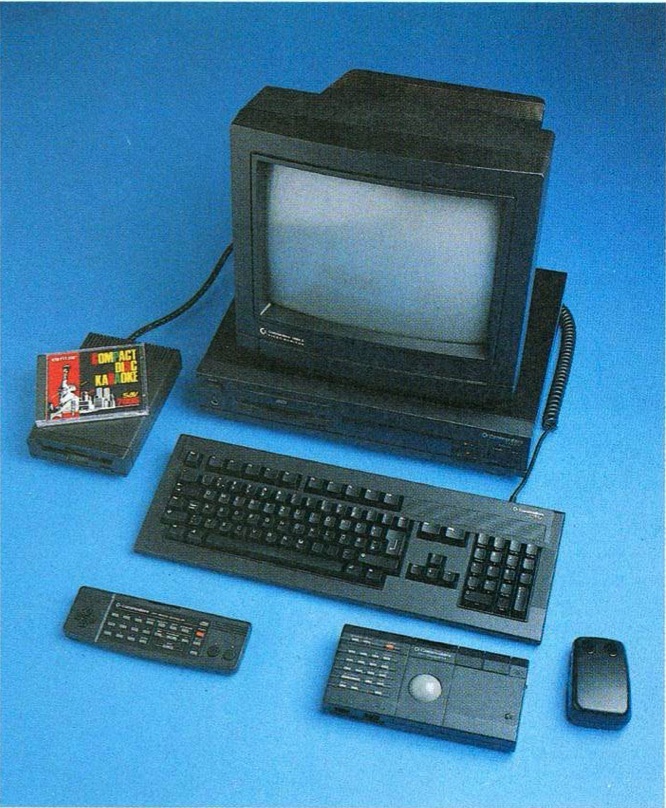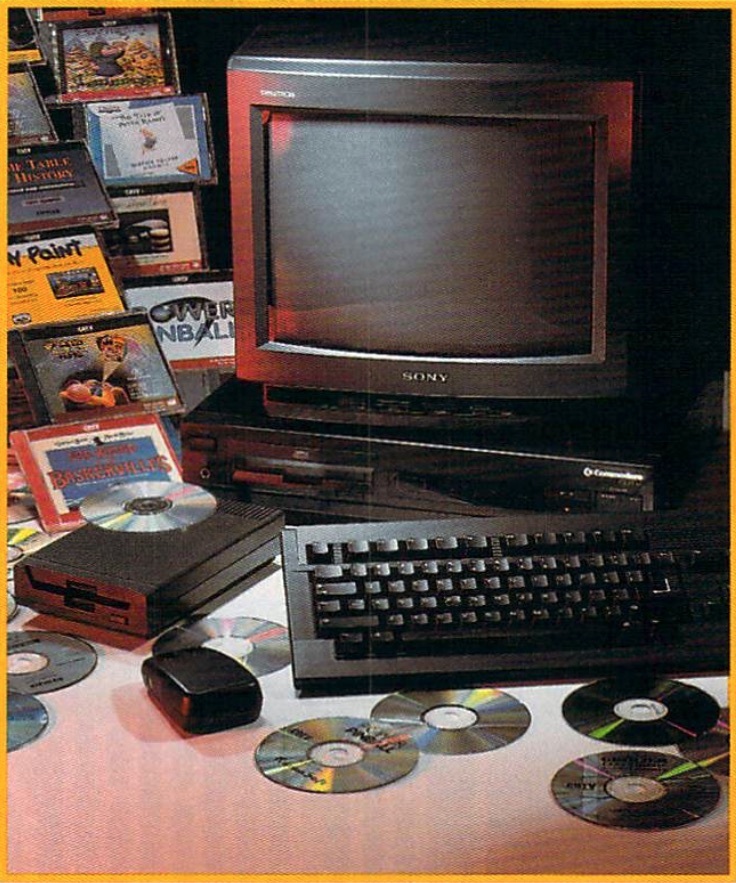
The merciless price slashing that Commodore employed on their ill-fated CDTV line in the early 1990s is the stuff of legends. I decided to take a closer look at how CDTV retail prices developed during those turbulent years and try to place the price cuts in a historical context.
While I was compiling some stats for the article on “How Many A570/A690 Units Did Commodore Make” I decided to visualize the price drops of the three main SKUs[1]: the CD1000 (CDTV player), the Multimedia pack (CDTV player + accessories bundle), and the A570 CD-ROM drive. And it ain’t pretty. Have a look at this:
The absolutely brutal price slashing of the CDTV line of products (1991-1993)
The blue line represents the price of the standalone CDTV player (CD1000) that was released in April 1991. The purple line represents the price of the Amiga CDTV Multimedia Pack, released in 1992 when CDTV was rebranded as Amiga CDTV and also became available as part of a bundle (with keyboard, diskdrive and mouse), that turned it into a full computer. Finally the yellow line represents the price of the A570 CD-ROM Drive, an add-on for the A500 which made it compatible with CDTV software (CDTV titles).
Note: The prices in this chart are in Pounds Sterling (GBP) and for the most part recommended retail prices (RRP), which were published in adverts of major UK Amiga dealers in Amiga magazines, since the UK was one of the biggest Amiga markets worldwide. To get a rough feel for how much the prices would be in US dollars in 1991-1993, multiply the GBP prices by about 1.75.[2]
If we look at the development of the retail prices between 1991 (launch) and 1993 (end-of-life) there are really five key moments that we can identify, which I have labeled 1 through 5 on the chart:
- 1991 holidays
- A500 trade-in offer
- 1992 holidays
- Pre-CD32 announcement
- Post-CD32 announcement
Let’s have a more in-depth look at each of these.
1991 Holiday Season
The CDTV player was released in April 1991[3] [4] [5] and technically already had a 100 GBP price cut before it was even released. The initial RRP was set to a stunning 699 GBP, although Commodore changed their mind shortly before the product launch and lowered the RRP to 599 GBP.[6] The first “real” price cut consequently occurred at the beginning of Q4 1991, where another 100 GBP was slashed off the price making the CDTV player available for 499 GBP.
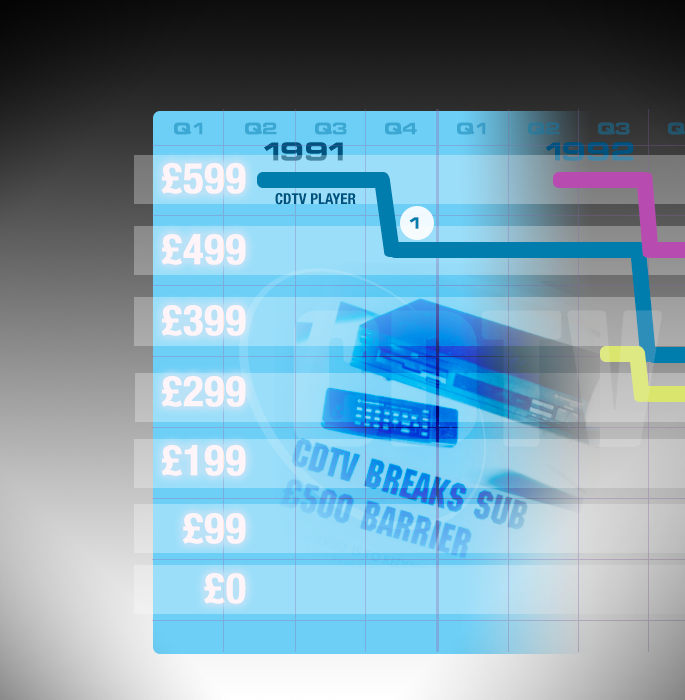
Price cut in time for 1991 holiday season
The holiday season is a common period to introduce price cuts in order to stimulate sales. And CDTV sales sure needed stimulating. Since its introduction in April only 6,000 players were sold in the UK,[7] which was a far cry from the 50,000 units Commodore expected to be able to sell in the UK alone before the end of 1991[8] [6] and was definitely not on target for the 350,000 – 500,000 units Commodore expected to sell worldwide in the first year.[10] Panic had not set in yet, but the early signs were undoubtedly worrying for Commodore who had a lot riding on CDTV.
A500 Trade-in Promotion
Although technically Commodore maintained the 499 GBP price point for the CD1000 player until the end of Q3 1992, in reality things were somewhat more nuanced because of a trade-in offer that started mid 1992 and ran until late September.[11] By trading in their A500, the best selling Amiga model in history, users would get a 200 GBP discount. The newly introduced CDTV Multimedia Pack was therefor available for 399 GBP and the standalone player for just 299 GBP after trade-in.

The generous A500 trade-in discount
After emphasizing that CDTV was not to be positioned as a computer, but as a consumer appliance[12] and Commodore UK sales manager Kelly Sumner even going so far as to call for a four foot “exclusion zone” between in store displays so that CDTV would not be mixed up with PCs/computers,[13] come 1992 all that hoopla went out the window when Commodore made a complete U-turn and started marketing the player as Amiga CDTV, i.e. as a computer. The desperation was starting to get palpable, because only 15,000 to 17,000 units had been sold by early 1992 in the UK [14] and production of CDTV players had already been halted as far back as September 1991 when the last CD1000 rolled off the assembly lines.[15]
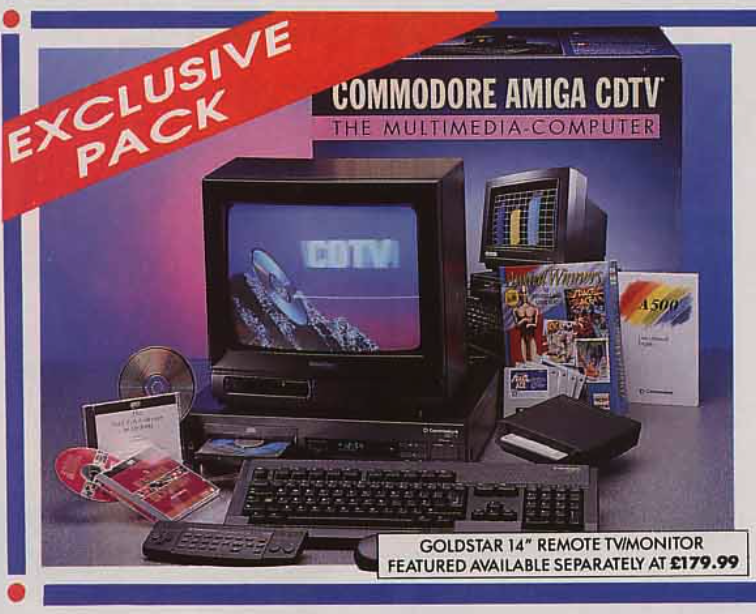
CDTV Multimedia Pack ad (1992)
1992 Holiday Season
The A500 trade-in offer ended late September, but Commodore had already lined up their next price cuts for the 1992 holiday season. The Amiga CDTV Multimedia pack was dropped from 599 GBP to 499 GBP and the standalone player was down to an RRP of 399 GBP, but its street price at some of the prominent UK Amiga dealers of the day was 369 GB [16] and even 355 GBP [17], marking a 130 GBP price cut.

Ho ho ho! Yet more price slashing for the 1992 holiday season
The A570 CD-ROM drive addon which finally made it into stores in Q3 1992 (after many delays), also received a 50 GBP price cut in October 1992 from 349 GBP to 299 GBP, a mere 2 months after its release.
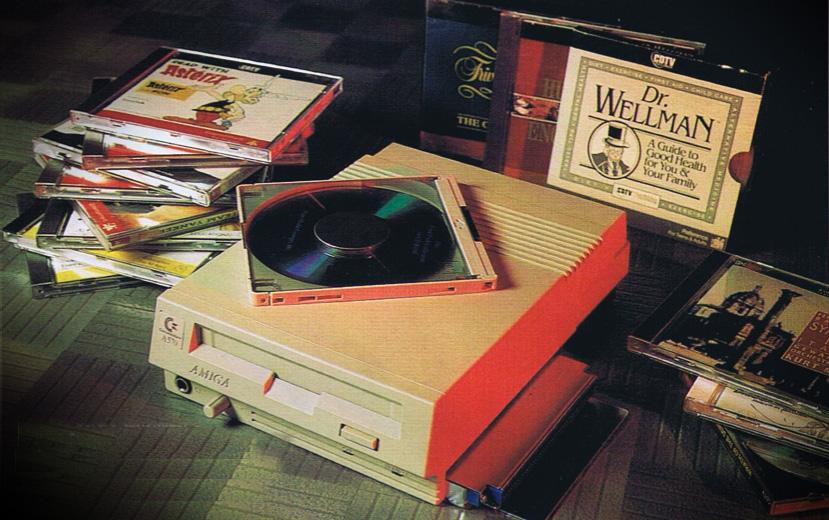
The A570 fared even worse than the CD1000
Amiga CD32 Release
If it hadn’t already become sufficiently clear by 1993 that Commodore had long ago given up on CDTV, any remaining pretense to the contrary was let go in April 1993, which is where see the most savage price cuts start to occur. By that point Commodore had already been secretly working on their new CD-based games console the CD32 for a while now and they were about to go public with the news.
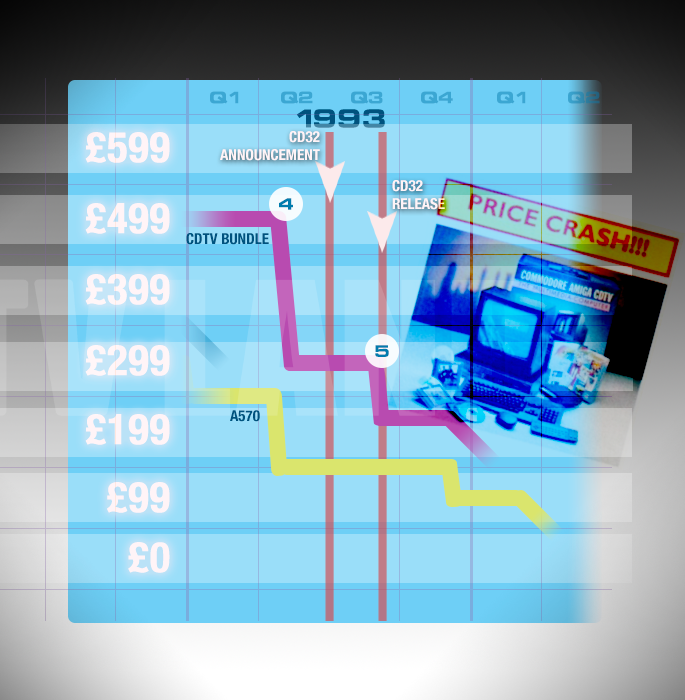
CD32 had a major impact on CDTV prices
The Amiga CDTV Multimedia Pack drops from 499 GBP to 299 GBP, just two months before the CD32 is announced and then drops further to just 229 GBP right after the CD32 is released. The A570 shows a similar pattern. While it had already received another price cut from 299 GBP to 249 GBP in Q1, it gets an additional 100 GBP slashed off the price and it becomes available for just 149 GBP, two months before the CD32 announcement. Then dropping even down to 99 GBP after the CD32 is released. The product was being sold at street prices that were well below cost to Commodore.
The A570’s race to the bottom
In July 1993 Commodore announced the existence and impending release of the Amiga CD32 games console. To the unpleasant surprise of many parties involved the CD32’s release was hastily pulled forward many months from its originally intended 1994 release in what seems to have been a desperate attempt to generate revenue and stave off the inevitable.[18] A mission that was unfortunately doomed to failure, because Commodore Electronics Ltd[19] went into voluntary liquidation in April 1994.[20]
The price cut shortly before the CD32 announcement was well calculated, because it would get rid of loads of CDTV and A570 units at a price point that consumers probably would not have been prepared to pay after the CD32 had been announced. Then, after the CD32 did actually launch, we see the 5th and final price cut after which CDTV and A570 truly become bargain bin sales items. I would imagine that at this point Commodore UK would have liquidated all their remaining stock for peanuts and any remaining CDTV/A570 stock at that point was all in the distribution channel from where it would fan out to smaller dealers everywhere who would lower prices even further until stock sold or passed it on to other dealers. I personally remember buying the A570 brand new in box in June of 1994 at a trade show in the Netherlands for the equivalent of 35 GBP.
Analysis
Commodore invested a lot in CDTV. The CD1000 cost a fortune to produce, which can be attributed to several factors like the system being developed by a special projects team with most of the work being contracted out,[21] i.e. outside of Commodore’s regular engineering resources at West Chester, PA., and the product being rushed to market in order to beat Philips’ CD-i, its main rival in the stadium of interactive multimedia at the time. The CD1000 contained many new technologies that were very new and very expensive (the proprietary CD-ROM drive assembly cost $400 US a piece) and the system went from proof-of-concept to production in no time, without properly optimizing for costs.[21] [23] Multiply these costs by up to 80,000 units manufactured, add research and development costs, manufacturing costs and many more millions for promotion, then also throw in a couple of millions for the A690 and A570 drive and our back-of-the-envelope calculation easily adds up to a 50 million USD investment if not much more. The extremely high cost of producing the CDTV player left Commodore with very little margin to operate on and is mostly to blame for the very high retail price of the CD1000, which in turn is also mostly to blame for weak sales (among many other factors).
CD1000 with most of its original first party peripherals
“The system was really given little more than 6 months to prove itself”
The huge investment and the extremely thin overall profit margin ratios of Commodore’s parent company[24] (CIL) also left Commodore with a strategy that depended on CDTV being a hit right out of the gate, which of course did not happen. After a slow start Commodore had their hopes set for the 1991 holiday season for sales to pick up. When the 1991 holiday season came and went and the very disappointing sales figures came in, the decision to flip-flop and sell the CDTV player as a computer (and see if that sticks) was made. [25] The system was really given little more than 6 months to prove itself, after which the original vision of CDTV as a consumer appliance was already diluted by a campaign touting the CDTV player as a computer, creating an incredibly confusing message to consumers. Both CDTV and CD-i were a new class of entertainment devices and it was hard for the average consumer to understand what they did and why they would need one. By changing their strategy and adding an identity crisis into the mix Commodore just doubled down on the confusion.
Appliance vs Computer
The repositioning of CDTV as a computer was hastily decided and just wasn’t thought through properly from a technical (and subsequent usability) perspective either. The CD1000’s specs were based on the A500, which itself was mostly a cost reduced version of (and similar in specs to) the A1000 which was released in 1985. By 1991 this was old tech, but as it was encapsulated into a consumer appliance, this wasn’t that big of a deal. The CDTV OS user interface looked very fancy by 1991 standards and abstracted away the clunky underlying 1.3 Kickstart/AmigaDOS. As far as the aging hardware is concerned, Carl Sassenrath, creator of the Amiga’s Exec kernel and many components of the CDTV OS states in an interview: “The hardware itself is OK. You don’t need much of the processor time to do multimedia as it’s all pictures on the screen and audio – almost all of which happens on the Amiga’s DMA. The CPU simply sets things up and away you go.”[26]. And this statement makes perfect sense if you position the CD1000 as a multimedia consumer appliance, which was the original plan.
CDTV turns into a full computer
But computers aren’t appliances… In computerland specs do matter a whole lot more. While selling CDTV as a multimedia consumer appliance disguised many of the hardware shortcomings, the decision to change tactics and sell the CD1000 as a computer ultimately had quite the opposite effect and only emphasized these shortcomings, because people use a computer differently from an appliance. A computer could be expected to do much more than just run multimedia titles on CD-ROM (just like we today expect our PC or Mac to perform more tasks than a PS5 or Xbox Series X) and by 1992 the specs of the CD1000 as a computer were very much outdated. A 68000 CPU with 1 MB of memory, which contrary to the A500 could hardly be expanded and came with an old version of the Amiga operating system, was a hard sell in 1992.
To add insult to injury, many games and other software that worked fine on an A500 (which users were encouraged to trade in for a CD1000, no less), did not work on the CD1000, because it had less memory available due to the fact that the CDTV OS took up some extra memory. Users had to resort to installing a switch that disables the CDTV OS ROMs to get some A500-compatible software to run. An unfortunate by-product of this process was that it rendered the CD-ROM drive non-functional as well as any (very expensive) SCSI harddisks connected to the CDTV player. It also required opening up the player, which would void the warranty unless done by an authorized dealer.
“CDTV was trying to be a closed platform and an open platform at the same time”
Another unfortunate issue is that, due to Commodore’s own licensing restrictions, only CDTV titles could automatically boot on the CD1000 and A570. Normal Amiga CD-ROMs could technically boot just fine,[27] but were restricted from doing so. Users were forced to boot the system from floppy disk in order to gain access to files on Amiga CD-ROMs that weren’t authored specifically for CDTV. Again, this restriction and licensing model made sense from the perspective of the CD1000 being a (semi-closed) appliance, but when you start using the CD1000 as a computer it just becomes a very non-sensical and very user-unfriendly “feature”. CDTV was trying to be a closed platform and an open platform at the same time, which was just such an ill-informed approach by Commodore.
I think it is indicative of a scenario where the repositioning of CDTV as a computer was just a hastily invoked Plan B that nobody in management really bothered to work out in detail, because the short sighted focus was on getting the product out the door as quickly as possible instead of building a sustainable market. When even that ill-fated Plan B failed to generate significant sales, that’s when Commodore was only left with one more dial to turn and that was the slashing of the retail prices, which they continued to do and the rest as they say, is history. And so was CDTV.
Alternate Reality
The more I learn about CDTV’s history the more I appreciate this machine. Only a company like Commodore could squander a fortune like that to beat the behemoth Philips to market in the interactive multimedia revolution of the early 1990s, and for a while look like they were actually winning, but then just as quickly screw everything up (as they often did) and totally self destruct and go bankrupt, rockstar style.

The legendary CD1000 CDTV player
I mean, the fact that the CD1000 player even exists at all feels like an anomaly, a glitch in the matrix. It feels like something that should not exist. Something that looks like it’s from an alternate timeline or some parallel universe, that somehow managed to cross over into our universe. Just look at it! An Amiga, arguably the most advanced home computer line of its day, inside a beautiful case that somehow manages to still look classy so many decades after its release, featuring compact disc technology (lasers!), remote control, memory cards, genlock, CD+G, CD+MIDI and much more obscure early 1990s tech all wrapped up in a dreamy vision of a grand future that sadly never came to pass. At least not quite the way Commodore (or Philips for that matter) imagined it… But it’s here and it’s real. (And I love it!)
And we have Commodore to thank for that!
Footnotes
- SKU means Stock Keeping Unit and is a way in business of identifying an inventory item ↩
- The Pound Sterling to US Dollar conversion rates between 1991 and 1993 hovered between 1.5 and 2 US dollars. Source: https://www.poundsterlinglive.com/bank-of-england-spot/historical-spot-exchange-rates/gbp/GBP-to-USD-1991 ↩
- Source: “World of Amiga Feels Pier Pressure” – Amiga World – July 1991 issue ↩
- Source: “Amiga ’91 Berlin” – Amiga Shopper – July 1991 issue ↩
- Source: “CDTV Launches” – Amiga Format – June 1991 issue ↩
- Source: “CBM Profits Slump Fails to Dampen CDTV Hopes” – New Computer Express, February 2, 1991 issue. ↩
- Source: “The Year of the Compact Disc” – Amiga Format, January 1992 issue ↩
- Source: “What’s New” – Amiga Computing – April 1991 issue ↩
- Source: “CBM Profits Slump Fails to Dampen CDTV Hopes” – New Computer Express, February 2, 1991 issue. ↩
- Source: “CDTV Launch Delayed” – Amiga Computing – November 1990 issue. ↩
- Source: Amiga CDTV A500 trade-in ad Commodore – Amiga Format – September 1992 issue ↩
- Source: Steve Franklin, Managing Director of Commodore UK at ECTS London, April 1991 ↩
- Source: “Trade Show Gets Serious” – The One magazine, June 1991 issue ↩
- Source: “Amiga Continues as Best Seller” – Amiga Computing, March 1992 issue. ↩
- Based on observed production week codes on serial number stickers of CD1000 production units. See for more details: “How Many CDTV Units Did Commodore Make“ ↩
- Available from “Silica Systems”, Kent and “First Computer Center”, Leeds, UK ↩
- Available from “Dynamite Computers”, Bedford, UK. ↩
- Source: David Pleasance in “Commodore: The Inside Story” – David Pleasance ↩
- Commodore Electronics Ltd is the entity that basically bore all the economic risks in the complicated web of legal entities that comprised Commodore as a whole. ↩
- Source: “Commodore International Going Out Of Business” – New York Times, 30 April 1994 edition. ↩
- Source: Jeff Porter, lead engineer at Commodore – Viva Amiga B-roll footage ↩
- Source: Jeff Porter, lead engineer at Commodore – Viva Amiga B-roll footage ↩
- Source: Beth Richard in “Commodore: The Inside Story” – David Pleasance. ↩
- Source: “Commodore Financial History, 1978-1994” – The Silicon Underground, David L. Farquhar ↩
- Source: Commodore International Ltd FY 1992 Q2 report to shareholders. Dated February 10th 1992, it says: “In order to enhance future CDTV player sales, we commenced an effort to broaden our distribution and market CDTV as a computer with the appropriate accessories.” ↩
- Source: Carl Sassenrath interview – “A Man With a Dream” – Amiga CD! Magazine – Issue 1 – 1993 ↩
- CDTV OS 2.35 removes this restriction and allows any ISO9660 Amiga CD-ROM to boot. ↩


